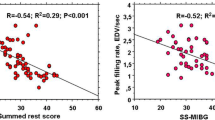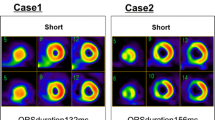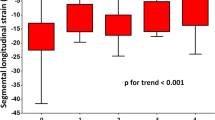Abstract
Purpose
This study aims to investigate the relationship between cardiac sympathetic nervous function (CSNF) and myocardial perfusion/function in patients with heart failure (HF) due to dilated cardiomyopathy (DCM) or ischaemic heart disease (CAD).
Methods
Twenty patients (10 DCM, 10 CAD, 17 males, age 69±5 years) with NYHA class IIIb HF were studied. CSNF was evaluated by early/delayed 123I-metaiodobenzylguanidine (MIBG) uptake and regional washout (WO). Myocardial perfusion and function were evaluated by 99mTc-tetrofosmin gated single-photon emission tomography (G-SPECT) using a 20-segment model for 400 segments. In each segment, regional MIBG WO was computed as (count density in early images−count density in delayed images/count density in early images)×100.
Results
DCM and CAD showed similar summed rest perfusion score (6.7±5 vs 9.5±5, p=NS) and mean ejection fraction values (29±7% vs 30±9%, p=NS). By contrast, the summed thickening score was higher in DCM than in CAD patients (26±7 vs 17±6, p<0.05). QGS analysis identified akinesis/dyskinesis in 129/137 (94%) severely hypoperfused segments which were considered as damaged. According to the underlying aetiology of HF, marked differences in regional MIBG WO were observed. In fact, within the CAD group, regional MIBG WO was lower in reference than in damaged segments (38±21% vs 46±19%, p<0.05). By contrast, in DCM patients, regional MIBG WO was faster in reference than in damaged segments (49±18% vs 41±30%, p<0.05). When the two groups were directly compared, regional MIBG WO from damaged areas was similar irrespective of the underlying disease, while it was faster in DCM than in CAD patients from reference segments.
Conclusion
These data confirm the hypothesis that the presence of myocardial necrosis in HF due to CAD and the consequent loss of neuronal endings cause alterations in regional MIBG WO different from those observed in DCM.



Similar content being viewed by others
References
Meredith IA, Eisenhofer G, Lambert GW, Dewar E, Jennings GL, Esler MD. Cardiac sympathetic nervous activity in congestive heart failure. Evidence for increased neuronal norepinephrine release and preserved neuronal uptake. Circulation 1993;88:136–45.
Rundquist B, Elam M, Bermann-Sverrisdottir Y, Eisenhofer G, Friberg P. Increased cardiac adrenergic drive precedes generalized sympathetic activation in human heart failure. Circulation 1997;95:169–75.
Chidsey CA, Braunwald E, Morrow AG, Mason DT. Myocardial norepinephrine concentration in man: effect of reserpine and of congestive heart failure. N Engl J Med 1963;269:653–8.
Cohn JN, Levine TB, Olivari MT, Garberg V, Lura D, Francis GS, et al. Plasma norepinephrine as a guide to prognosis in patients with chronic congestive heart failure. N Engl J Med 1984;311:819–23.
Kaye DM, Lefkovits J, Jennings GL, Bergin P, Broughton A, Esler MD. Adverse consequences of high sympathetic nervous activity in the failing human heart. J Am Coll Cardiol 1995;26:1257–63.
Boehm M, La Rosee K, Schwinger RH, Erdmann E. Evidence for reduction of norepinephrine uptake sites in the failing human heart. J Am Coll Cardiol 1995;25:146–53.
Ungerer M, Hartmann F, Karoglan M, Chlistalla A, Ziegler S, Richardt G, et al. Regional in vivo and in vitro characterization of autonomic innervation in cardiomyopathic human heart. Circulation 1998;97:174–80.
Merlet P, Dubois-Rande JL, Adnot S, Bourguignon MH, Benvenuti C, Loisance D, et al. Myocardial beta-adrenergic desensitization and neuronal norepinephrine uptake function in idiopathic dilated cardiomyopathy. J Cardiovasc Pharmacol 1992;19:10–6.
Merlet P, Benvenuti C, Moyse D, Pouillart F, Dubois-Rande JL, Duval AM, et al. Prognostic value of MIBG imaging in idiopathic dilated cardiomyopathy. J Nucl Med 1999;40:917–23.
Henderson EB, Kahn JK, Corbett JR, Jansen DE, Pippin JJ, Kulkarni P, et al. Abnormal I-123 myocardial metaiodobenzylguanidine washout and distribution may reflect myocardial adrenergic derangement in patients with congestive heart cardiomyopathy. Circulation 1988;78:1192–9.
Wolpers HG, Nguyen N, Rosenspire K, Haka M, Wieland DM, Schwaiger M. C-11 hydroxyephedrine as a marker for neuronal catecholamine retention in reperfused canine myocardium. Cor Art Dis 1991;2:923–9.
Allman KC, Wieland DM, Muzik O, Degrado TR, Wolfe ER, Schwaiger M. Carbon-11 hydroxyephedrine with positron emission tomography for serial assessment of cardiac adrenergic neuronal function after acute myocardial infarction in humans. J Am Coll Cardiol 1993; 22:368–75.
Schwaiger M, Guibourg H, Rosenspire K, McClanahan T, Gallagher K, Hutchins G, et al. Effect of regional myocardial ischemia on sympathetic nervous system as assessed by fluorine-18-metaraminol. J Nucl Med 1990;31:1352–7.
Minardo JD, Tuli MM, Mock BH, Weiner RE, Pride HP, Wellman HN, et al. Scintigraphic and electrophysiologic evidence of canine myocardial sympathetic denervation and reinnervation produced by myocardial infarction or phenol application. Circulation 1988;78:1008–19.
Matsunari I, Schricke U, Bengel FM, Haase HU, Barthel P, Schmidt G, et al. Extent of cardiac sympathetic neuronal damage is determined by the area of ischemia in patients with acute coronary syndromes. Circulation 2000;101:2579–85.
Mardon K, Montagne O, Elbaz N, Malek Z, Syrota A, Dubois-Rande JL, et al. Uptake-1 carrier downregulates in parallel with the beta-adrenergic receptor desensitization in rat hearts chronically exposed to high levels of circulating norepinephrine: implications for cardiac neuroimaging in human cardiomyopathies. J Nucl Med 2003;44:1459–66.
Yamakado K, Takeda K, Kitano T, Nakagawa T, Futagami Y, Konishi T, et al. Serial change of iodine-123 metaiodobenzylguanidine (MIBG) myocardial concentration in patients with dilated cardiomyopathy. Eur J Nucl Med 1992;19:265–70.
Slomka PJ, Nishina H, Berman DS, Kang X, Friedman JD, Hayes SW, et al. Automatic quantification of myocardial perfusion stress-rest change: a new measure of ischemia. J Nucl Med 2004;45:183–91.
Germano G, Erel J, Lewin H, Kavanagh PB, Berman DS. Automatic quantitation of regional myocardial wall motion and thickening from gated technetium-99m sestamibi myocardial perfusion single-photon emission computed tomography. J Am Coll Cardiol 1997;30(5):1360–7.
Nakajima K, Bunko H, Taki J, Shimizu M, Muramori A, Hisada K. Quantitative analysis of 123I-meta-iodobenzylguanidine (MIBG) uptake in hypertrophic cardiomyopathy. Am Heart J 1990;119:1329–37.
Narula J, Sarkar K. A conceptual paradox of MIBG uptake in heart failure: retention with incontinence! J Nucl Cardiol 2003;10:700–4.
Parodi O, De Maria R, Oltrona L, Testa R, Sambuceti G, Roghi A, et al. Myocardial blood flow distribution in patients with ischemic heart disease or dilated cardiomyopathy undergoing heart transplantation. Circulation 1993;88:509–22.
Estorch M, Narula J, Flotats A Mari C, Tembl A, Martin JC, et al. Concordance between rest MIBG and exercise tetrofosmin defects: possible use of rest MIBG imaging as a marker of reversible ischaemia. Eur J Nucl Med 2001;28:614–9.
Mann DL, Kent RL, Parsons B, Cooper G. Adrenergic effects on the biology of the adult mammalian cardiocyte. Circulation 1992;85:790–804.
Opie LH, Thandroyen FT, Muller CA, Bricknell OL. Adrenaline induce “oxygen wastage” and enzyme release from working rat heart. Effects of calcium antagonism, betablockade, nicotinc acid and coronary artery ligation. J Mol Cell Cardiol 1979;11:1073–94.
Harding VB, Jones LR, Lefkowitz RJ, Koch WJ, Rockman HA. Cardiac BARK1 inhibition prolongs survival and augments beta blocker therapy in a mouse model of severe heart failure. Proc Natl Acad Sci U S A 2001; 98:5809–14.
Author information
Authors and Affiliations
Corresponding author
Rights and permissions
About this article
Cite this article
Marini, C., Giorgetti, A., Gimelli, A. et al. Extension of myocardial necrosis differently affects MIBG retention in heart failure caused by ischaemic heart disease or by dilated cardiomyopathy. Eur J Nucl Med Mol Imaging 32, 682–688 (2005). https://doi.org/10.1007/s00259-004-1735-2
Received:
Accepted:
Published:
Issue Date:
DOI: https://doi.org/10.1007/s00259-004-1735-2




